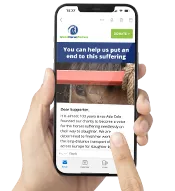Plan for an emergency when you’re not around – help us to help your horse
Deputy Chief Field Officer Jon Phipps has top tips for owners on making plans just in case your horse injures themselves when you’re not there.
Posted on 04/11/2021

The chances are that your horse could well injure themselves when you’re not around – either at work or away on holiday, for example – and we may end up being called by passers-by, or the vet might get called out by someone else on the yard. We’ll need to be able to get in touch with you when we get there, so it’s really important that you leave your contact details with at least two people and/or at the yard.
Amongst the reasons that it’s key for us (or a vet) to be able to get in touch with you is that we won’t have any idea what your horse is usually like to handle – and in particular if we can’t catch them we can’t help them. It’s also very useful to know if they’re already under the vet for the condition that’s led to us being contacted, or even another one entirely. We will also need someone to be able to make decisions about the horse’s care, which is really difficult if we can’t speak with the owner.
One option is to have a laminated card with contact details on pinned up in the tack room/by the gate – and it’s worth including alternative contact details here too. It’s also very important to make sure your horse’s microchip details are up to date – you can check this using the Chipchecker or via your Digital Stable if you’ve set yourself up an account.
If your paddock or yard gate is usually locked, do make sure someone has a spare key – if we can’t get the gate open we can’t take the horse to the vets for you even if we do manage to contact you and you give the go ahead for treatment.
It’s also very helpful to make sure your horse loads! If your horse is a bit rusty at travelling a bit of loading practice would be well worth it. It’s a good idea to do some loading training on a reasonably regular basis anyway if your horse doesn’t go out and about normally, just in case you do need to suddenly take them to the vets in an emergency situation. (You can check out our blog on loading and travelling your horse safely here.)
If your horse is unhandled or not halter trained, have a plan as to where they can be safely confined for treatment in an emergency and make sure they’re used to going in there in a calm, non-stressful situation. You should let your alternative contacts know too, in case we can’t reach you.
Other things to consider are making sure you know where your horse’s passport (and/or ScotEquine card if you’re in Scotland) and insurance details are, so these can be easily located in an emergency. If you don’t have a set place for them, in the stress of an emergency situation it can be very easy to forget where you last had them.
Whilst you’re making plans, it would also be worth checking out our Just In Case materials as well, which you can find on our Equine End of Life page.
For more advice on planning for an emergency, what to do while you wait for the vet and to brush up on your equine first aid skills, check out our equine first aid webinar below.
You can catch up on all our previous Welfare Wednesday webinars as well as finding out about upcoming ones here.
Topics
Related Blog Posts

How to help a needle-shy horse overcome their fear
Grooms Amy and Emily explain how they work with horses who are nervous with needles before a visit from the vet.

What does biosecurity mean and how do you quarantine a new horse?
Research and Education Officer Alana Chapman shares simple steps you can take to prevent an outbreak of disease on your yard.
Recommended News Articles

Nineteen fly-grazed Shire horses rescued from Kidderminster
Six charities joined forces to rescue 19 fly-grazing Shire horses from Kidderminster.

2020 Conference looks at the horse-human partnership
Virtual conference discusses the horse-human partnership and what's in it for horses.

Rescue pony Clyde shows how your donation can help transform horses’ lives this winter
Welsh pony gelding Clyde came into our care severely neglected but has been transformed to take Reserve Champion Rescue Pony at Equifest this year.
Enjoy reading stories like this?
Join over 65,000 other horse lovers and sign up for our email newsletter

Join over 65,000 other horse lovers and sign up for our email newsletter
Sign me up now